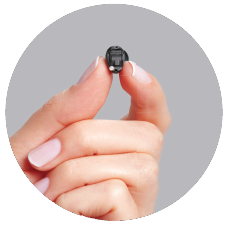
100% Invisible
100% Amazing
 Many patients have asked us why we don’t fit the Lyric© hearing system that has been so heavily advertised in this area. The answer is simple: first, we feel like that product is not a good value for our patients. Secondly, we knew that something better was coming down the line.
Many patients have asked us why we don’t fit the Lyric© hearing system that has been so heavily advertised in this area. The answer is simple: first, we feel like that product is not a good value for our patients. Secondly, we knew that something better was coming down the line.Introducing AGX9—the world’s first 100% digital, 100% invisible hearing technology. Whereas other deep insertion products (like Lyric) used out-dated analog technology, AGX9 offers all of the functionality of the best hearing aids in the world, in the tiniest package that we’ve ever seen.
 The red hearing aid in the above picture shows where a normal in the canal aid would fit in the ear-- slightly visible to someone looking straight into your ear. The black aid is the new AGX9 technology-- completely hidden in the ear.
The red hearing aid in the above picture shows where a normal in the canal aid would fit in the ear-- slightly visible to someone looking straight into your ear. The black aid is the new AGX9 technology-- completely hidden in the ear.We could tell you all about the engineering and programming that make it possible, but what you really need to know is simple:
You will hear better and no one will be able to see how.
AGX9 features include:
- Invisible-in-the-Canal The only 100% custom, invisible, digital and fully programmable hearing aid
- PureWave Feedback Eliminator Virtually eliminates buzzing and whistling
- Voice iQ Designed to maintain speech understanding in noise and reduce listening effort*
- T2 Remote Lets you adjust memory or volume settings using any touch-tone phone
If you are interested in more information about this revolutionary hearing product, please give us a call to schedule an appointment with one of our AudigyCertified™ audiologists.
“I’ve never heard sound quality like this from a hearing aid.”
Larry, AGX9 wearer
“It’s like I got my ears back. I don’t even notice I’m wearing them—I just hear again.”
Dave, AGX9 wearer
AGX9 technology is only available in Utah County at Timpanogos Audiology. Call us at 801-770-0801 to schedule a free consulation to see if AGX9 is right for you.

